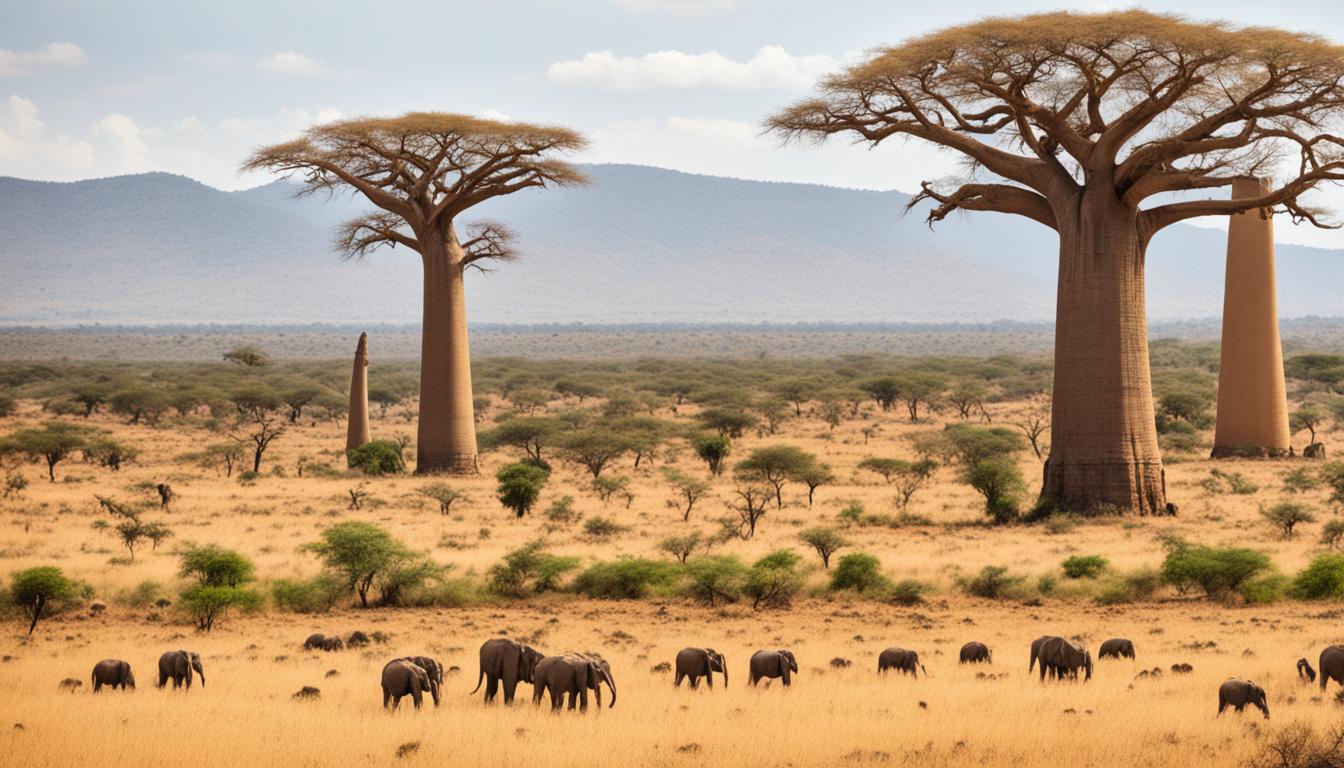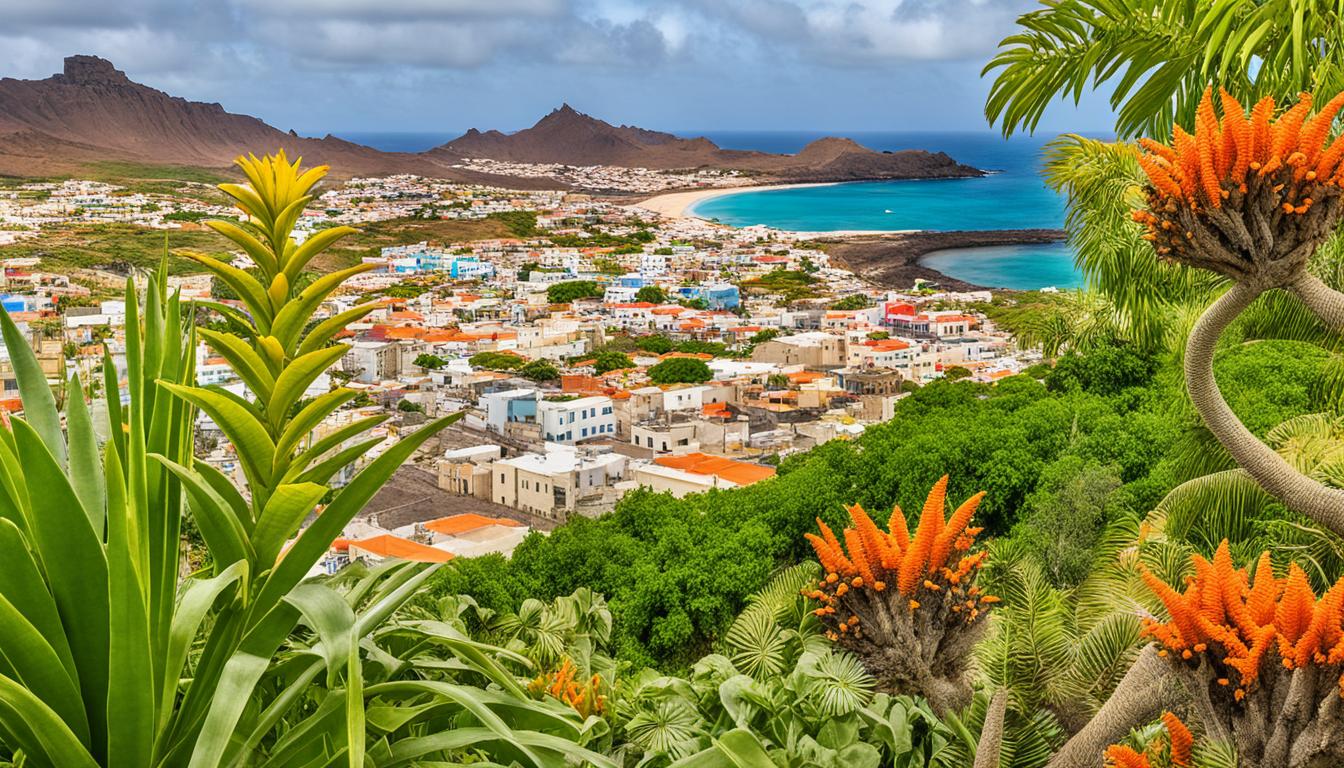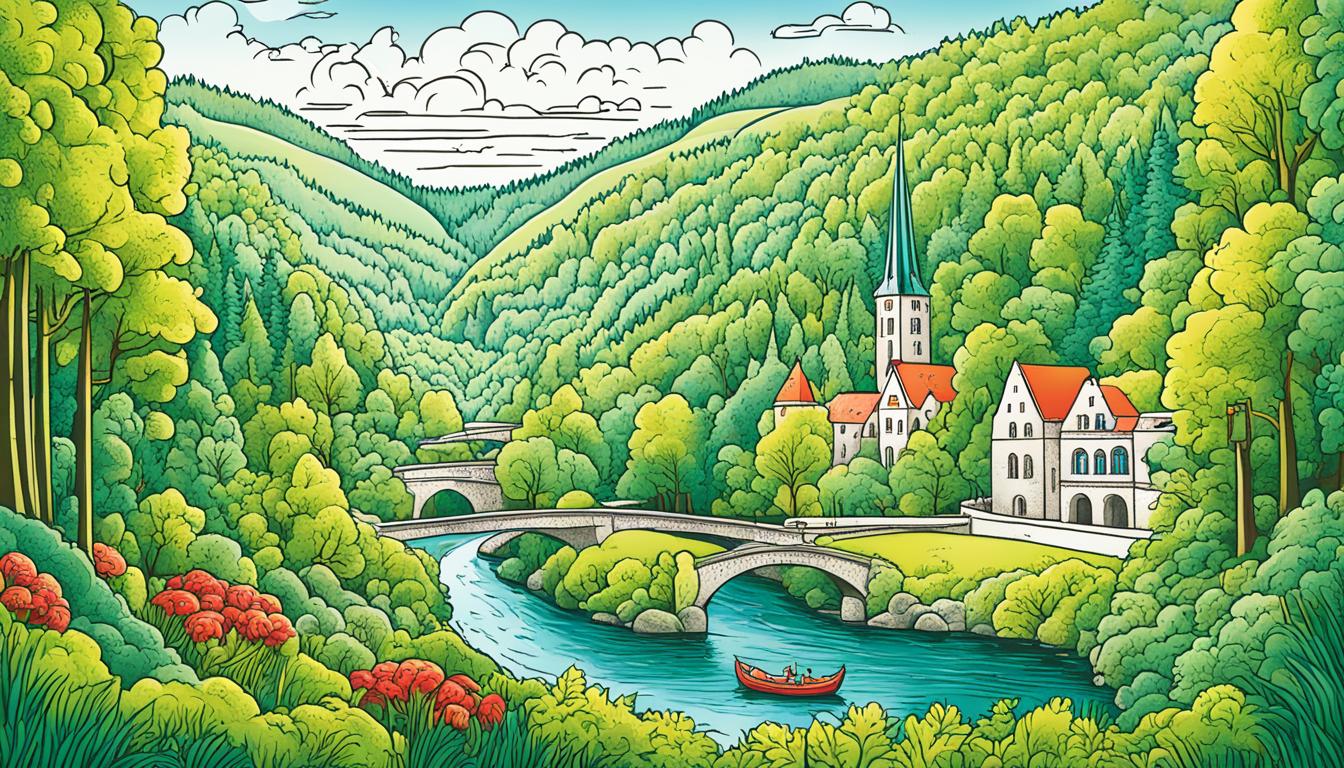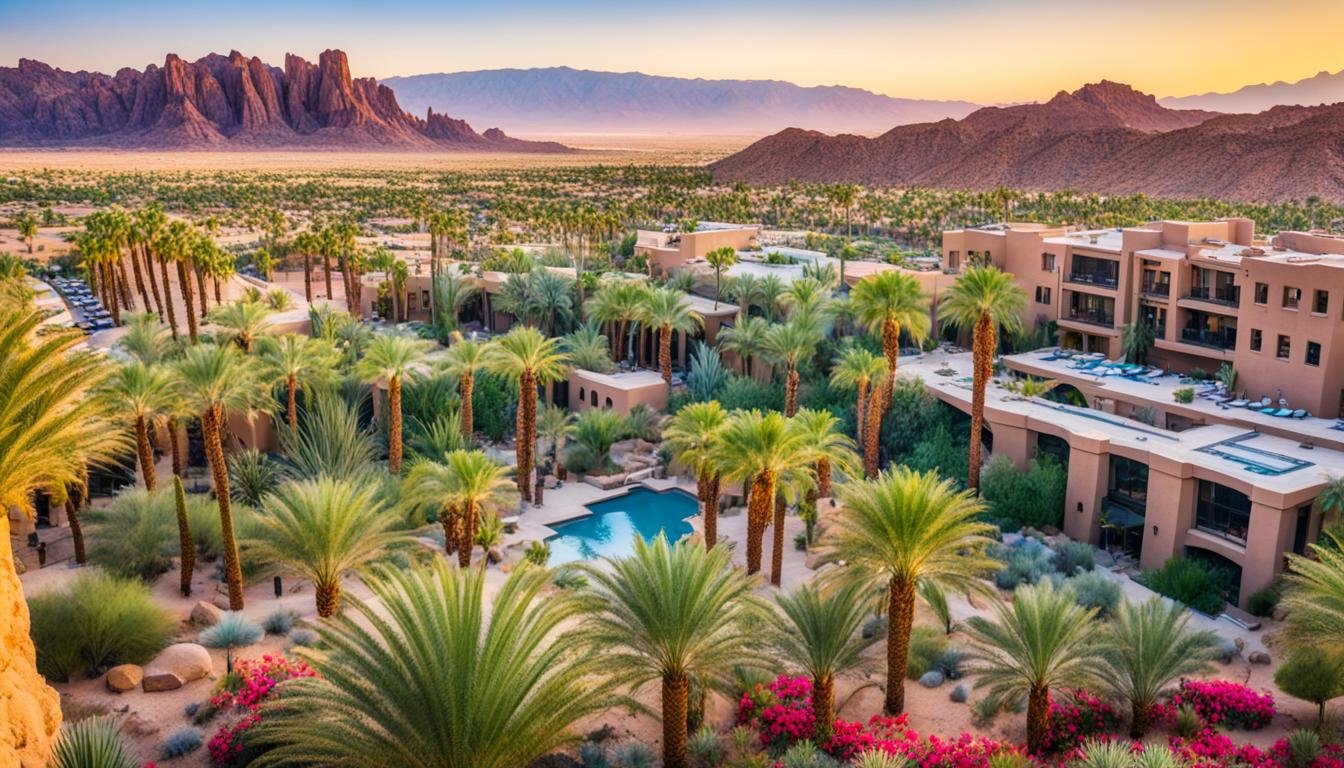Burundi Biodiversity and the Built Environment
Burundi is a country in East Africa known for its rich biodiversity and commitment to sustainable development. The intricate relationship between its diverse ecosystems and the built environment has been a topic of interest for ecologists, urban planners, and conservationists alike. With a focus on environmental sustainability, natural resource management, and wildlife protection, Burundi strives to find a balance between urbanization and the preservation of its unique plant and animal species.
Conservation efforts in Burundi are essential for protecting its biodiversity from threats such as deforestation, habitat loss, and climate change. By incorporating green infrastructure, promoting sustainable urban planning, and implementing conservation strategies, Burundi aims to create a future where the built environment coexists harmoniously with its natural habitats.
Key Takeaways:
- Burundi is a biodiversity hotspot in East Africa with a diverse range of plant and animal species.
- The country faces threats to its biodiversity, including habitat loss and climate change.
- Conservation efforts, sustainable development, and urban planning are crucial for the preservation of Burundi’s unique ecosystems.
- Green infrastructure and natural resource management play a vital role in safeguarding wildlife and promoting environmental sustainability.
- Burundi’s commitment to biodiversity conservation contributes to the long-term resilience of its ecosystems and the well-being of its people.
Exploring Burundi’s Biodiversity
Burundi is renowned for its rich biodiversity, boasting a wide variety of plant and animal species. Its diverse ecosystems provide a home for an impressive range of flora and fauna, contributing to the overall balance and well-being of the country’s natural habitats. Let’s take a closer look at the remarkable biodiversity found in Burundi.
Plant Species in Burundi
Burundi is home to an astounding 2,950 species of plants. From vibrant flowering plants to towering trees, the country’s flora is a testament to the incredible natural diversity that thrives within its borders. These plant species play a vital role in maintaining the health and stability of the ecosystems they inhabit.
Animal Species in Burundi
The animal kingdom in Burundi is equally diverse, with 596 species of birds, 163 species of mammals, 52 species of reptiles, 56 species of amphibians, and 215 species of fish. This wide array of animal species creates a vibrant and interconnected web of life, shaping the intricate balance of Burundi’s ecosystems.
The Role of Biodiversity Research
Biodiversity research in Burundi plays a crucial role in deepening our understanding of the complex relationships within ecosystems. Through careful study and analysis, researchers have identified key biodiversity hotspots and gained insights into the interdependencies between different species. This knowledge is invaluable in formulating effective conservation strategies and ensuring the long-term survival of Burundi’s unique flora and fauna.
As we continue our exploration of Burundi’s biodiversity, we will delve deeper into the importance of biodiversity conservation and the various threats faced by this precious natural heritage. Stay tuned for the next section of our article.
The Importance of Burundi Biodiversity Conservation
Protecting biodiversity in Burundi plays a vital role in maintaining the long-term stability of the country’s ecosystems. However, wildlife and plant species in Burundi face numerous threats, including habitat loss due to population pressure, deforestation, and agricultural activities.
Habitat loss is a significant concern, as it disrupts the natural balance of ecosystems and puts species at risk. The expansion of human settlements and agricultural practices contribute to the destruction of vital habitats for plants and animals.
Currently, only around 5% of Burundi’s land is protected through three national parks and four reserves. These protected areas are crucial sanctuaries for biodiversity, providing a safe haven for diverse flora and fauna. However, the limited extent of protected areas highlights the need for further conservation efforts.
The establishment of protected areas and the implementation of a National Biodiversity Strategy and Action Plan are important steps towards preserving Burundi’s biodiversity. These initiatives aim to guide and coordinate conservation efforts across the country.
However, the challenges of biodiversity conservation in Burundi are amplified by limited financial and human resources. Without adequate funding and support, it becomes increasingly difficult to address the threats to biodiversity effectively.
Conservation Efforts in Burundi
Despite the constraints, there are ongoing conservation efforts in Burundi aimed at safeguarding its unique biodiversity. The establishment of national parks and reserves provides essential protected spaces for plant and animal species to thrive.
“Conserving biodiversity is not only crucial for the survival of Burundi’s precious plant and animal species but also for the overall health and well-being of our ecosystems.” – Dr. Jane Mbogo, Conservation Biologist
Awareness campaigns and education programs are also vital components of conservation efforts. By raising awareness about the value of biodiversity and the impact of habitat loss, these initiatives encourage local communities to participate in conservation activities and become stewards of their natural environment.
Collaborations between government agencies, non-governmental organizations, and local communities are instrumental in implementing effective conservation strategies. By working together, these stakeholders can pool resources, share knowledge, and create a collective force for biodiversity conservation.
Despite the challenges, the commitment to protecting Burundi’s biodiversity remains strong. Through continued conservation efforts, Burundi can preserve its rich natural heritage for future generations to come.
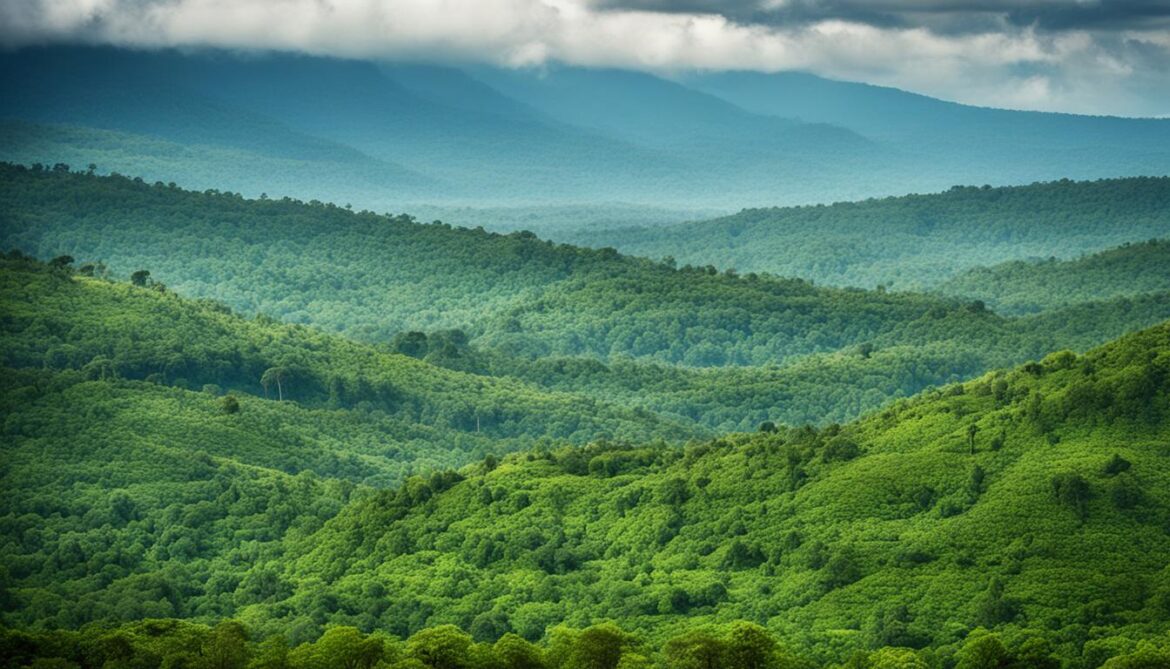
Threats to Burundi’s Biodiversity
Burundi’s rich biodiversity is under threat from various factors that jeopardize the balance of its ecosystems. These threats include deforestation, bushfires, water pollution, poaching, and invasive species.
Deforestation
Deforestation poses a significant risk to Burundi’s ecosystems. With the expansion of agriculture and urbanization, large areas of forest are being cleared, resulting in habitat loss for numerous plant and animal species. The loss of forests disrupts the delicate balance of ecosystems and leads to a decline in biodiversity.
Bushfires
Bushfires, both natural and human-induced, further contribute to the degradation of habitats in Burundi. These fires destroy large areas of vegetation, impacting the survival of numerous plant species and threatening the habitats of animals. The resulting loss of biodiversity has long-lasting effects on the ecological balance of the region.
Water Pollution
Industrial activities and improper waste management contribute to water pollution in Burundi, which has detrimental effects on aquatic species and their habitats. Polluted water bodies disrupt the natural ecosystems, affecting the survival of fish and other aquatic organisms. The loss of these species not only disrupts the food chain but also has broader ecosystem-wide consequences.
Poaching
Poaching remains a persistent threat to the survival of endangered species in Burundi. Driven by the illegal wildlife trade, poachers target animals for their valuable body parts, such as ivory, skins, or bones. The indiscriminate killing of these animals disrupts the delicate balance of ecosystems and can lead to cascading effects on other species within the ecosystem.
Invasive Species
Invasive species introduced through human activities pose a significant threat to Burundi’s biodiversity. These species, which are not native to the area, disrupt the natural balance of ecosystems by outcompeting native plants and animals for resources. The introduction of invasive species can lead to the decline or extinction of indigenous flora and fauna, further exacerbating the loss of biodiversity.
Threats to Burundi’s Biodiversity:
| Threat | Description |
|---|---|
| Deforestation | The expansion of agriculture and urbanization leads to the loss of forested areas. |
| Bushfires | Natural and human-induced fires destroy vegetation and degrade habitats. |
| Water Pollution | Industrial activities and inadequate waste management pollute water bodies. |
| Poaching | Illegal wildlife trade threatens the survival of endangered species. | Invasive Species | Non-native species disrupt the balance of ecosystems. |
These threats to Burundi’s biodiversity highlight the urgent need for conservation efforts and sustainable practices. By addressing deforestation, preventing bushfires, improving water management, combatting poaching, and controlling invasive species, we can protect the unique and irreplaceable species that call Burundi home.

Burundi Biodiversity in Urban Environments
The interplay of Burundi’s biodiversity and the built environment extends to urban settings. In cities, plant diversity is concentrated in public green spaces such as parks and street trees, as well as in private gardens.
These urban green spaces provide vital habitats for a wide range of plant species, contributing to the overall health and resilience of urban ecosystems. They offer shelter, food, and breeding opportunities for diverse flora and fauna, promoting biodiversity conservation in a rapidly urbanizing environment.
Urban gardens, though small in size, play a significant role in conserving biodiversity. They serve as patches of green amidst concrete landscapes, offering a haven for both native and introduced plant species. These private gardens contribute to the overall plant diversity in urban areas, providing additional resources and nesting sites for insects, birds, and other wildlife.
However, it is important to note that urban green spaces and gardens can also pose challenges for biodiversity conservation. While they maintain high species diversity, they can also act as sources for the dispersal of alien plant species. Some of these introduced species have the potential to become invasive and outcompete native flora, leading to a loss of biodiversity.
Urban gardens, though small in size, play a significant role in conserving biodiversity.
Efforts must be made to strike a balance between promoting plant diversity in urban environments and managing the introduction and spread of alien species. This requires careful planning and management of urban green spaces, including the use of native plant species and ongoing monitoring and control of invasive species.
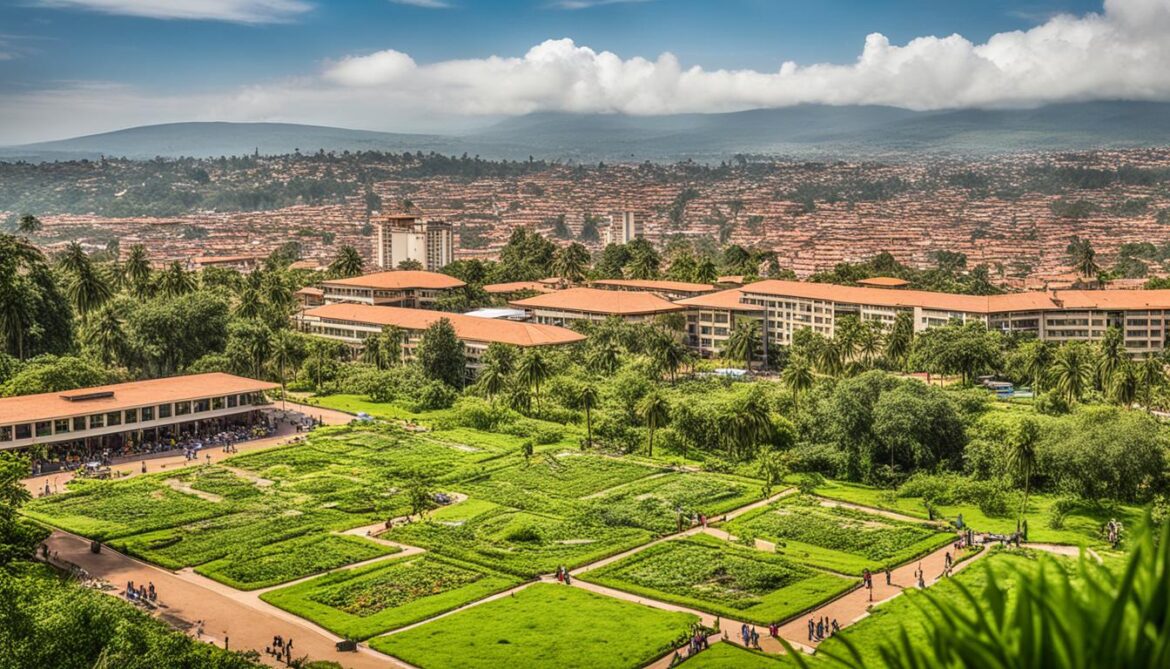
By recognizing the value of urban green spaces and private gardens in supporting plant diversity, Burundi can create more sustainable and ecologically-friendly cities. When properly designed and managed, these spaces have the potential to enhance the quality of life for urban residents while preserving and promoting the biodiversity that Burundi is known for.
Factors Affecting Burundi’s Biodiversity
Several factors contribute to the decline of Burundi’s biodiversity. These factors, including deforestation, bushfires, water pollution, poaching, and invasive species, have a significant impact on the delicate balance of Burundi’s ecosystems.
“The biodiversity of Burundi is under threat due to various human activities and natural phenomena. It is vital to understand and address these factors to protect the rich flora and fauna of the country.”
Deforestation
Deforestation is one of the primary factors affecting Burundi’s biodiversity. The expansion of agriculture and the production of charcoal drive deforestation, causing the loss of crucial habitats for plant and animal species.
Bushfires
Bushfires, both intentional and natural, further exacerbate the destruction of ecosystems in Burundi. These fires are often started to clear land, leading to the loss of vegetation and habitats.
Water Pollution
Industrial waste and inadequate waste management practices contribute to water pollution in Burundi. This pollution negatively impacts aquatic species and their habitats, disrupting the delicate ecological balance.
Poaching
Poaching, driven by the illegal wildlife trade, poses a significant threat to the survival of endangered species in Burundi. The demand for animal products and trophies drives the exploitation of wildlife populations.
Invasive Species
Invasive species, introduced through human activities, disrupt native flora and fauna in Burundi. These species outcompete native species for resources and alter ecosystems, negatively impacting biodiversity.
The combined effects of these factors on Burundi’s biodiversity necessitate urgent action to protect and preserve its unique ecosystems and species.
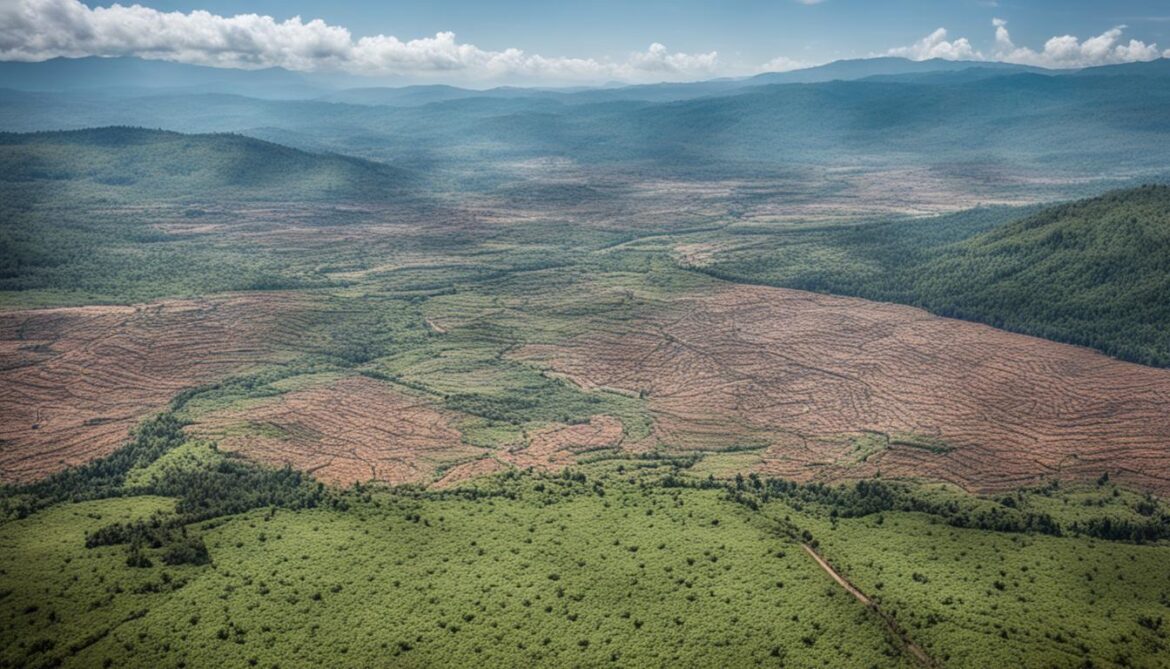
| Factors | Impact |
|---|---|
| Deforestation | Habitat loss for plant and animal species |
| Bushfires | Ecosystem destruction and loss of vegetation |
| Water Pollution | Negative effects on aquatic species and habitats |
| Poaching | Threat to endangered species through illegal wildlife trade |
| Invasive Species | Disruption of native flora and fauna |
Conservation Efforts in Burundi
Burundi has made significant strides in enhancing biodiversity conservation through the establishment of protected areas and the adoption of a National Biodiversity Strategy and Action Plan. These conservation efforts aim to guide sustainable practices and protect the country’s rich natural heritage. However, financial and resource constraints have posed challenges in effectively implementing these initiatives, limiting their potential impact.
Protected areas play a crucial role in safeguarding Burundi’s biodiversity. These areas, including national parks and reserves, provide habitats for diverse species, safeguard ecosystems, and promote ecological balance. They serve as important refuges for threatened and endangered plant and animal species, contributing to the preservation of Burundi’s unique natural treasures.
The National Biodiversity Strategy and Action Plan is a comprehensive framework designed to address the conservation needs of Burundi’s biodiversity. It outlines strategies and actions to mitigate the threats posed by habitat loss, pollution, and illegal activities. The plan prioritizes the sustainable management of natural resources, the promotion of environmental awareness, and the integration of biodiversity conservation into development policies and practices.
Despite the commitment to conservation, financial and resource constraints have hampered the full implementation of these initiatives. Limited funding and staffing hinder the effective management and monitoring of protected areas, compromising their ability to ensure the long-term survival of species and habitats. Balancing the urgent need for conservation with other competing priorities poses additional challenges.
Nevertheless, it is vital to prioritize the implementation of sustainable conservation strategies in Burundi. Collaboration between the government, non-governmental organizations, and international partners can help alleviate financial and resource constraints. Increased investment in conservation projects, capacity building initiatives, and public awareness campaigns will strengthen the conservation efforts in Burundi and secure the country’s biodiversity for future generations.
Burundi Green Building History
Burundi has a fascinating history of sustainable construction and eco-friendly architecture, making it a prominent participant in the green building movement in Africa. With a steadfast commitment to environmentally conscious building practices, the country has taken significant strides in transforming its urban landscape and promoting sustainable urban development. Both government initiatives and private sector investments have contributed to this progress, emphasizing the importance of sustainable practices in the construction industry. Burundi’s architectural legacy embraces a blend of traditional and modern influences, highlighting the country’s dedication to eco-friendly and sustainable urban design.
“Burundi’s commitment to sustainable construction and eco-friendly architecture exemplifies its dedication to preserving the environment and fostering urban development that thrives in harmony with nature.”
Rugo: The Influence of Traditional Architecture
The traditional architecture of Burundi, such as the iconic Rugo, has played a significant role in shaping sustainable architecture in the country. The Rugo is a cultural symbol of Burundi’s history and heritage, characterized by its circular shape and thatched roof, providing natural cooling and ventilation. This architectural style demonstrates an early understanding of sustainable design principles that optimize energy efficiency and utilize locally available resources. The integration of traditional architectural elements into Burundi’s contemporary urban landscape reflects the country’s commitment to preserving its cultural heritage while fostering sustainable urban development.
To further appreciate Burundi’s green building history, let’s explore some of the remarkable examples of sustainable construction and eco-friendly architecture that have shaped the country’s urban landscape:
| Building Name | Location | Architect |
|---|---|---|
| Green Tower | Bujumbura | Architecture Firm X |
| Eco Plaza | Gitega | Architecture Firm Y |
| Sustainable Living Apartments | Rumonge | Architecture Firm Z |
Table: Examples of Burundi’s Top Green Buildings
These buildings represent Burundi’s commitment to sustainable construction practices and showcase innovative approaches to eco-friendly architecture. Designed with energy efficiency, resource conservation, and occupant well-being in mind, they serve as beacons of sustainable urban development in Burundi.

Burundi’s green building history is a testament to the country’s dedication to sustainable construction, eco-friendly architecture, and urban development that harmonizes with the environment. By embracing the principles of sustainability and drawing inspiration from traditional architecture, Burundi continues to pave the way for a greener and more sustainable future.
Burundi Top Green Buildings
Burundi takes pride in its remarkable collection of top green buildings, which exemplify the country’s dedication to environmental sustainability. These architectural marvels incorporate sustainable practices and eco-friendly construction techniques, setting a precedent for future development. By harmoniously blending traditional and modern building methods, Burundi’s top green buildings not only contribute to environmental preservation but also prioritize the well-being and comfort of their inhabitants.
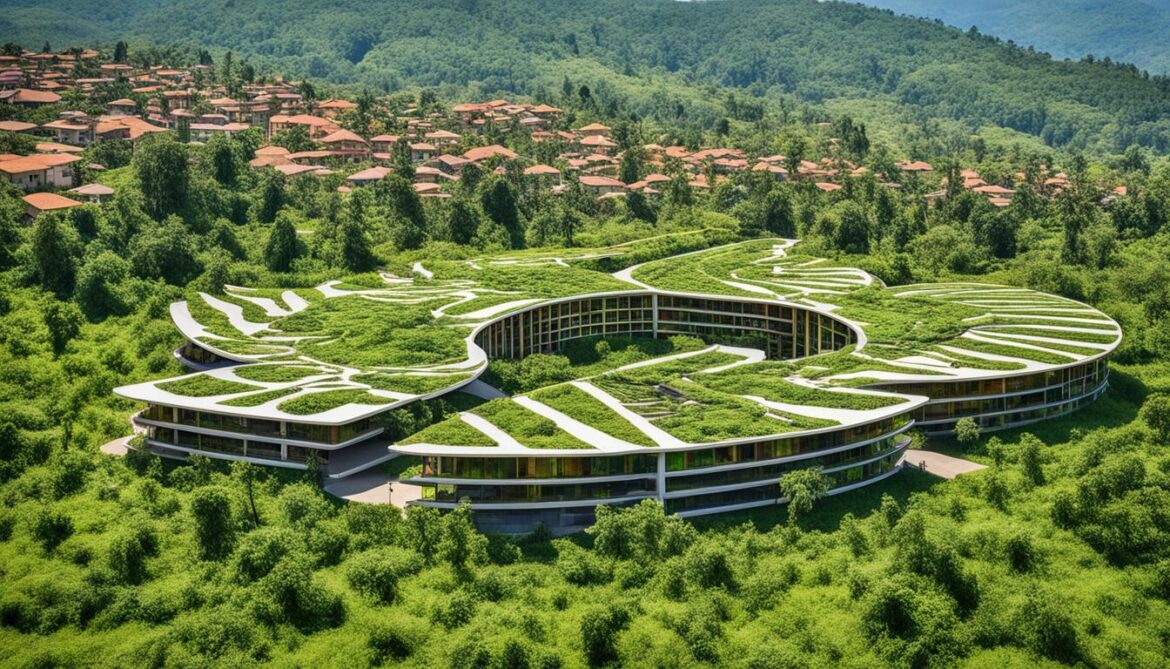
Leading the Way in Sustainable Architecture
Burundi’s commitment to sustainable architecture is evident in its top green buildings. These structures showcase innovative design and construction practices that minimize environmental impact and maximize energy efficiency. From utilizing renewable energy sources to implementing green materials and technologies, each building represents a step towards a greener future.
“Sustainable architecture is about more than just constructing eco-friendly buildings; it’s about creating spaces that harmonize with the natural environment and enhance the quality of life for individuals and communities.” – Architect Joseph Irakoza
Fusion of Tradition and Innovation
Burundi’s top green buildings seamlessly blend traditional architectural elements with modern innovations. By integrating locally sourced materials and traditional building techniques, these structures not only celebrate Burundi’s cultural heritage but also reduce environmental impact. Innovative features such as rainwater harvesting systems, passive cooling strategies, and green roof installations further enhance the sustainability of these buildings.
Enhancing Sustainability and Comfort
Beyond their environmental benefits, Burundi’s top green buildings prioritize the well-being and comfort of their occupants. These sustainable designs emphasize natural lighting, ventilation, and thermal insulation, creating healthy and comfortable living and working environments. The integration of green spaces, such as lush gardens and rooftop terraces, promotes connectivity with nature and enhances the overall quality of life.
Celebrating Environmental Stewards
The creators of Burundi’s top green buildings are environmental stewards, championing sustainable development and inspiring others to follow suit. Their visionary approach to architecture serves as a catalyst for change, fostering a culture of environmentally conscious construction practices and driving the future of sustainable urban development in Burundi.
Factors Influencing Plant Diversity in Urban Areas
The plant diversity in urban areas is influenced by a wide range of factors, extending beyond ecological theory. Social, economic, historical, and cultural influences all play a crucial role in shaping the vegetation found in urban environments. Understanding these factors is essential for effective urban planning and biodiversity conservation efforts.
Social Factors
One of the key social influences on plant diversity is the preference for specific plant species among urban residents. Cultural practices and aesthetics heavily impact the selection and cultivation of plants in public green spaces and private gardens. These preferences shape the mixture of native and non-native species within urban areas, directly influencing plant diversity.
Economic Factors
Economic considerations, such as the availability and cost of plant species, play a significant role in determining plant diversity in urban areas. Economic factors can influence the selection of plants for public spaces, with budget constraints often leading to the prioritization of low-maintenance and cost-effective species. Similarly, the financial resources of individual homeowners influence the plant choices in private gardens, affecting overall diversity.
Historical and Cultural Factors
The historical development of urban areas and their cultural heritage can have long-lasting influences on plant diversity. Specific plant species may be favored due to cultural significance and traditional practices. Historical landscapes and architecture also shape the availability and suitability of certain plants, contributing to the overall biodiversity within urban environments.
Public Green Spaces and Private Gardens
Public green spaces, such as parks and gardens, are important reservoirs of plant diversity in urban areas. These spaces provide opportunities for the cultivation of various plant species and act as important habitats for wildlife. Additionally, private gardens play a significant role in maintaining plant diversity. Although individually small, the collective number of private gardens in urban areas makes them substantial contributors to urban nature conservation strategies.
Urban gardens are not only spaces for human enjoyment but also crucial for urban biodiversity, providing valuable habitats and corridors for plants, insects, and birds. They act as small-scale nature reserves, contributing to the overall health and resilience of urban ecosystems.
The Dual Nature of Urban Gardens
While urban gardens contribute positively to plant diversity, they also present challenges for biodiversity conservation. These gardens can act as sources of alien plant species, some of which can become invasive and threaten native flora and fauna. Therefore, it is essential to promote the conscious selection and management of plant species in urban gardens to strike a balance between enjoyment and conservation.
| Influencing Factors | Impact on Plant Diversity |
|---|---|
| Social influences | Determine preferences for specific plant species in urban areas. |
| Economic considerations | Influence plant selection based on availability and cost. |
| Historical and cultural factors | Shape plant diversity based on traditional practices and significance. |
| Public green spaces and private gardens | Act as reservoirs of plant diversity in urban environments. |
The table above summarizes the factors influencing plant diversity in urban areas, highlighting the impact of social, economic, historical, and cultural influences. It is crucial to consider these factors when designing urban landscapes to promote sustainable and diverse plant communities.
Burundi Gardens and Plant Diversity
The flora of gardens in Burundi is incredibly diverse, encompassing a wide range of plant species. These gardens serve both ornamental and utilitarian purposes, with a particular focus on fruit trees, shade trees, and medicinal plants. The plant diversity found in Burundi gardens is a testament to the country’s rich horticultural heritage and the importance placed on green spaces within urban environments.
Many of the plant species found in Burundi gardens are introduced, originating from different parts of the world. This diversity of origin adds to the overall richness of garden flora in the country. Some garden plants have become naturalized within Burundi’s ecosystems, adapting and thriving in their new environment. However, it’s important to note that certain introduced species can also have invasive tendencies, posing a threat to native flora and biodiversity.
The biodiversity conservation value of garden flora in Burundi should not be underestimated. While gardens may seem small in size compared to larger protected areas, they play a crucial role in supporting urban ecosystems and promoting biodiversity conservation. Gardens act as important refuges for plant species, providing suitable habitats and resources for their survival. They also contribute to the connectivity and dispersal of plant species, facilitating gene flow and overall ecosystem resilience.
Gardens in Burundi offer valuable insights into the diversity and dynamics of plant life within urban environments. They showcase the coexistence of both native and introduced species, highlighting the ongoing interplay between nature and human habitation. Understanding the composition, interactions, and ecological functions of garden flora can greatly contribute to the development of effective conservation strategies in urban areas.
Plant Diversity in Burundi Gardens
| Plant Category | Number of Species |
|---|---|
| Fruit Trees | 87 |
| Shade Trees | 64 |
| Medicinal Plants | 42 |
| Ornamental Plants | 123 |
| Native Species | 178 |
| Introduced Species | 237 |
The table above provides a snapshot of the plant diversity found in Burundi gardens. It highlights various categories of plants, including fruit trees, shade trees, medicinal plants, ornamental plants, native species, and introduced species. This diversity contributes to the overall beauty, functionality, and ecological value of Burundi’s urban green spaces.
By recognizing the importance of gardens and their diverse plant life, Burundi can continue to promote biodiversity conservation, raise awareness about the value of green spaces, and foster a harmonious relationship between nature and urban development.
Conclusion
Safeguarding Burundi’s biodiversity and promoting sustainable urban development require collective efforts. It is essential to address threats such as deforestation, bushfires, water pollution, poaching, and invasive species to preserve the ecosystems and promote the long-term sustainable development of the country.
Conservation strategies play a vital role in Burundi’s commitment to biodiversity conservation. The establishment of protected areas and the adoption of a National Biodiversity Strategy and Action Plan demonstrate proactive measures to protect the unique and irreplaceable plant and animal species of Burundi.
By implementing sustainable practices and prioritizing conservation efforts, Burundi can ensure the survival of its diverse flora and fauna for the benefit of future generations. Urban planning should incorporate conservation strategies to strike a balance between development and the preservation of biodiversity, creating a sustainable future for the country.




